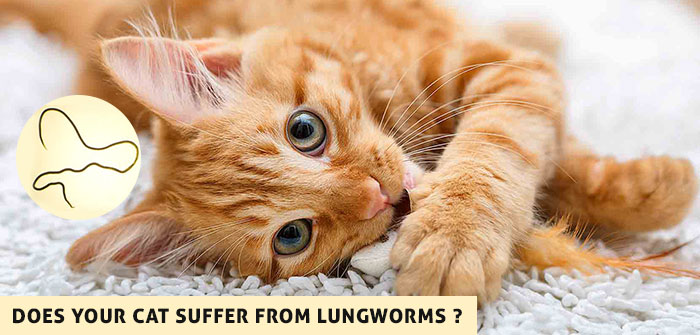Does your Cat Suffer from Lungworms?
The respiratory system is one of the vital structures of your cats body. Proper functioning of the respiratory organs like lungs is necessary for your cat to live a healthy life. You will not want to see that day when you are playing with your cat and your cat is suddenly falling short of breath. This can be heart-wrenching for you and a sign of severe lungworm infections in your cat. Lungworm infestation used to be very rare previously but recently these parasites have become more active and cases are increasing day by day. As a pet parent has to be more cautious while sending your cat out in open because lungworm larvae infest your pet when they are roaming in the woods and/or on fields and having fun.

And then these parasites settle in the windpipe of your pet and cause numerous respiratory problems. Therefore, to save your lovely kitty from lungworm infestations you should have proper knowledge of lungworms like their types, Symptoms of lungworms, Causes, Diagnosis and treatments of lungworms.
Lungworms in Cats – Symptoms , Causes, Diagnosis and Treatments
1. Types Of Lungworms
Aelurostrongylus abstrusus, Troglostrongylus subcrenatus, Oslerus rostratus, Gurltia paralysis are the species of lungworms usually found in cats and is often called Feline lungworms
Eucoleus aerophilus also known as Capillaria aerophila is found both in cats and dogs.
2. Symptoms of Lungworms in Cats
Adult Aelurostrongylus abstrusus lungworms lay eggs in the terminal respiratory bronchioles and alveolar ducts. The reaction that happens when the eggs hatch leads to breathing problems and in severe cases health issues like severe pulmonary disease, severe alveolar disease, shortness of breath (dyspnea) , bronchitis, emphysema, fluid build-up in the lungs and in critical situations it even leads to pneumonia. Increased numbers of larvae can show some symptoms however initially the symptoms are rare.
Cats with a lungworm infection history have a degree of immunity and may get away with small re-infections.
3. Causes
- Cats usually get infected by lungworms when they drink water or eat prey infested with lungworm larvae. These larvae then travel in the blood from the intestine and reach lungs. The immature parasites then develop into adult lungworms and lay eggs in trachea
- Eggs are then passed out through feces or coughed up.
- Lungworms are also passed on to young kittens when they come in contact with the feces of their mother or ingest it.
4. Diagnosis
There are several tests that can be done to diagnose the lungworm infestation in cats and they are-
- Examination of fluid from lungs (tracheal wash)
- Fecal examination for eggs
- Chest X-rays
- iv. Physical examination (lung auscultation) and history
- Complete blood count (CBC)5. Treatment
You don’t need to worry if you come to know about the lungworm infestation in your cat because your vet will suggest you many treatments that can completely eradicate lungworms from your cat’s lungs. Some of the most effective Anthelminthics are given below
- Levamisole
- Praziquantel
- Fenbendazole
- Albendazole
- Oxfendazole
- Ivermectin
- Moxidectin
[Read] Intestinal Parasitic Infection in Cats
It is always recommended to consult your vet if you see any type of symptoms related to lungworms. Treatment of lungworms in initial stages is easy. There are products with good efficacy in the market like Panacur granules for cats which contain Fenbendazole as an active ingredient. Panacur provides all-around treatment in worm infestations and also treats lungworms. This product is available on budgetpetcare.com
Breathing is the most basic activity that a living being does and as a cat parent, you can at least make sure that your kitty doesn’t experience any inhibitions in the most basic but the most important process called breathing.

